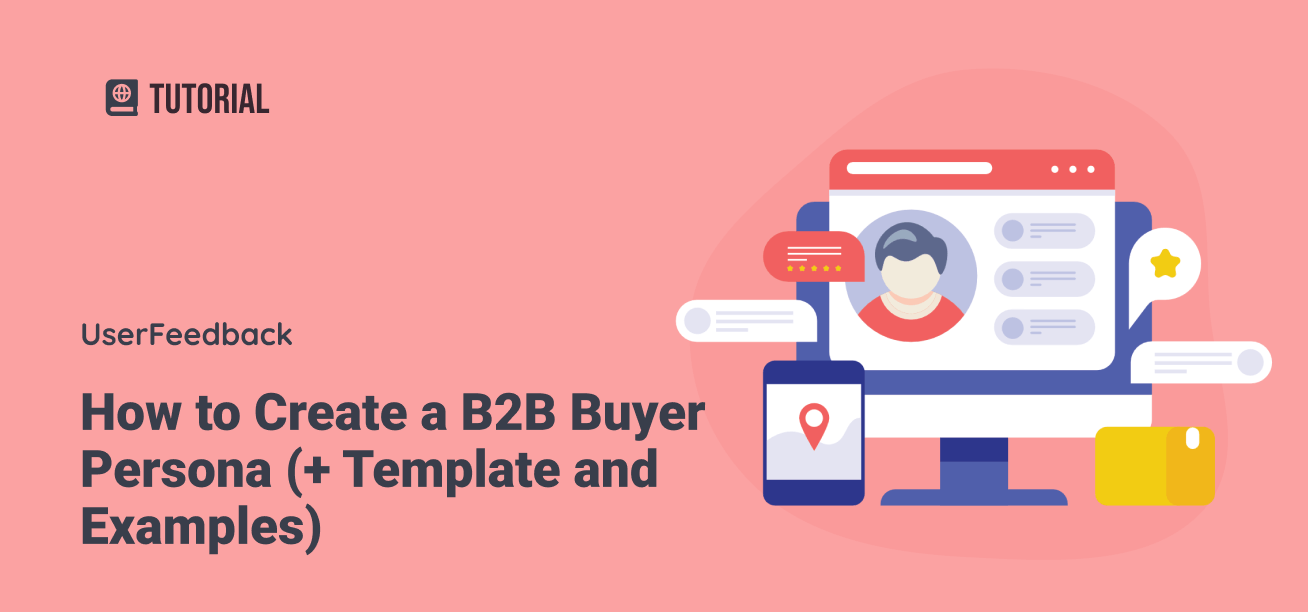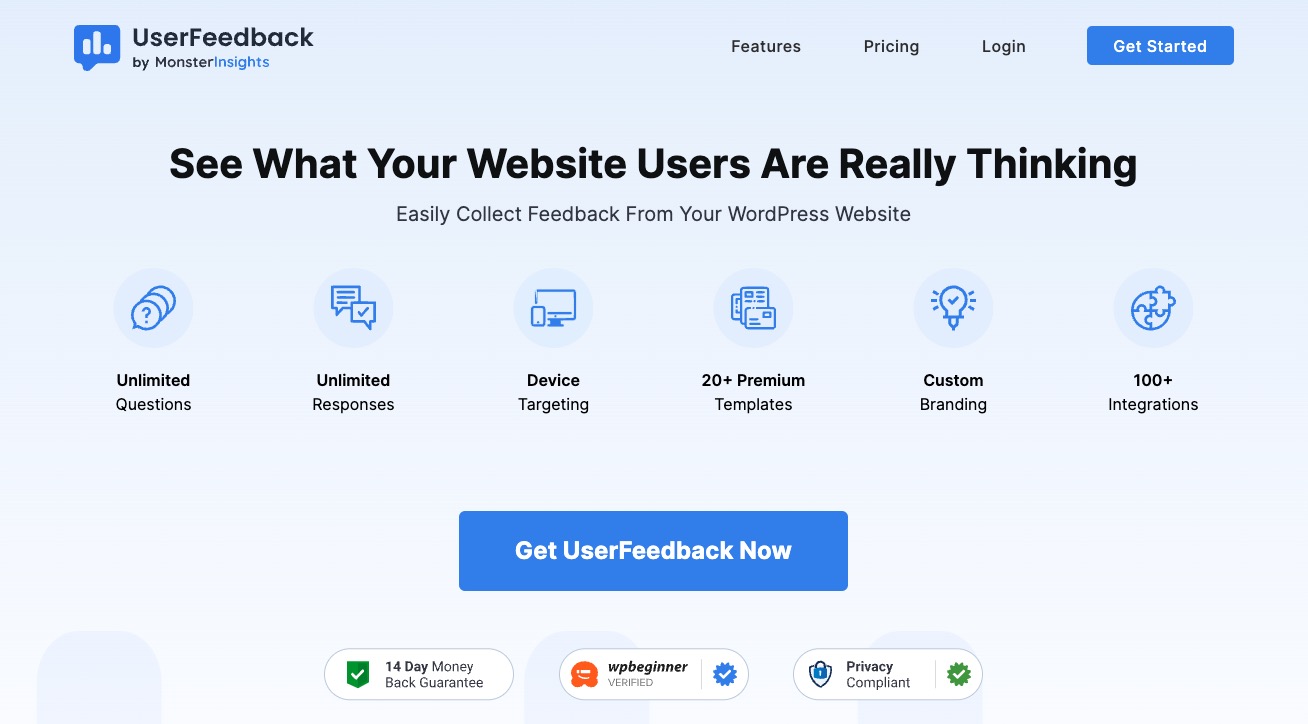Creating a B2B buyer persona is key to connecting with your audience and making your marketing more effective. It helps you shape your marketing to fit your business customers’ needs and challenges.
However, creating a B2B buyer persona from scratch can feel complicated and overwhelming if you’re unsure where to begin. With so many details to think about, it’s easy to get stuck.
But don’t worry! In this guide, I’ll show you how to create a B2B buyer persona step-by-step. I’ll share lots of helpful tips on what to focus on and how to use this to boost your business. Plus, you’ll get examples and a template that you can use.
Let’s jump in!
Table of Contents:
- Why Should You Create a B2B Buyer Persona?
- How to Use Buyer Personas in Marketing
- How to Create a B2B Buyer Persona (Step-by-Step)
- 4 B2B Buyer Persona Examples
- The Best Tool for Doing Buyer Persona Research: UserFeedback
Why Should You Create a B2B Buyer Persona?
Creating a B2B buyer persona is essential for any business that wants to build strong customer connections.
A persona is a representation of your ideal customer based on real data and insights. It helps you understand their needs and how to meet them, allowing you to craft marketing strategies that resonate more deeply with your target audience.
Here are some great reasons to create a B2B buyer persona:
- Personalize Marketing Efforts: By understanding your ideal customer’s demographics, challenges, and needs, you can create personalized marketing campaigns that speak directly to them.
- Inform Product Development: Knowing what your customers need allows you to develop products and services that cater to their specific problems, making your offerings more relevant and valuable.
- Optimize Content Strategies: With a clear picture of your audience, you can tailor your content and messaging to effectively reach and engage potential buyers at every stage of their journey.
- Enhance Lead Generation: Buyer personas help refine your lead generation processes by targeting the right people with the right message.
- Improve Customer Retention: Knowing what your customers care about enables you to provide them with the right support and solutions, leading to higher satisfaction and retention rates.
- Increase Revenue: By aligning your marketing, product development, and customer communication with your buyer personas, you enhance customer satisfaction and loyalty, ultimately boosting your sales and revenue.
Creating these personas might seem difficult at first, but it’s worth the effort. They form the backbone of a well-rounded marketing strategy, enabling you to make data-driven decisions that can significantly impact your success.
Let’s take a look at how you can use these buyer personas in your marketing strategy to drive even better results.
How to Use Buyer Personas in Marketing
Every business needs customers to succeed, which is why buyer personas are so important. Whether your business is big or small, creating personas helps you connect with your customers better and shape your strategies to fit their needs.
The Role of Buyer Personas
Buyer personas are your roadmap to creating targeted marketing campaigns. Here’s how to effectively use them:
- Segment Your Audience: Not all your customers are the same. By segmenting your audience based on different personas, you can tailor your messaging for each group. This makes your marketing much more effective.
- Develop Targeted Content: Understanding your personas allows you to create content that resonates with each segment. For example, you can send personalized emails that address the specific needs of each group rather than a one-size-fits-all message.
- Enhance Customer Journey Mapping: Use personas to map out your customer’s journey and identify key touchpoints where your brand can make a significant impact.
- Improve Product and Service Offerings: Insight from personas can guide your product development, ensuring that what you offer truly addresses your customer’s pain points and desires.
Creating Effective Buyer Personas
The process of creating buyer personas involves research and collaboration. Here’s a simple guide to get started:
- Research: Gather data from various sources like surveys, interviews, and sales feedback. Look for patterns in customer behavior and preferences.
- Identify Patterns: Analyze the data to find common traits among your customers.
- Create Personas: Develop profiles that represent your main customer types. Be as detailed as possible with demographics, behaviors, and needs.
- Integrate Personas into Marketing Strategies: Use these personas to guide content creation and customer interactions.
Using buyer personas in your marketing strategies helps you stay focused on delivering value to your customers.
Ready to start creating your buyer personas? Great, we’ll get to that next.
How to Create a B2B Buyer Persona (Step-by-Step)
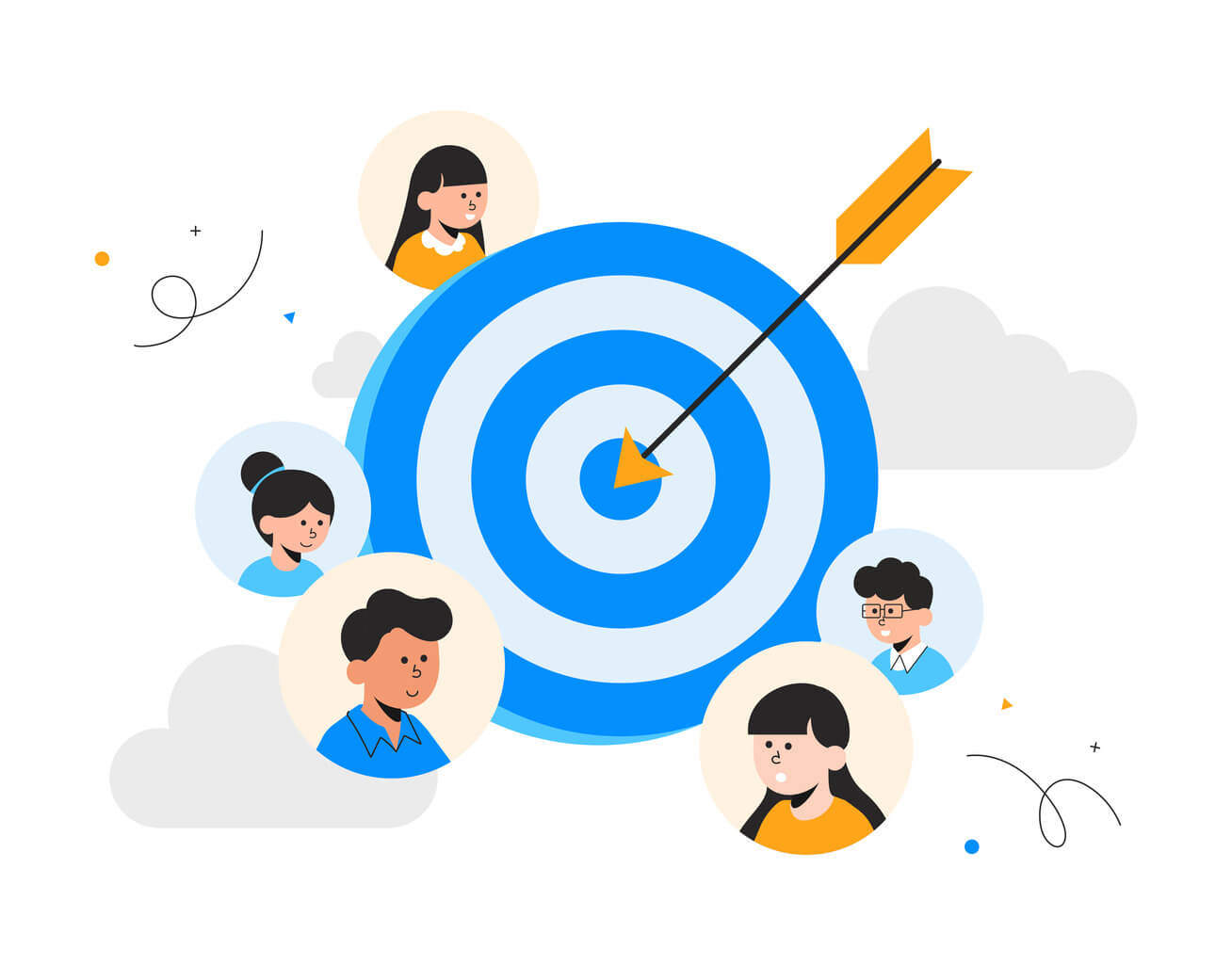
Creating a B2B buyer persona might seem tricky at first, but by breaking it down into steps and doing some thorough research, it becomes much simpler.
Here’s how to do it:
- Step 1: Research Your Customer
- Step 2: Analyze Your Research Data
- Step 3: Build Your B2B Buyer Persona
- Step 4: Create Your Marketing Strategy
Step 1: Research Your Customer
The first and most important step in crafting a B2B buyer persona is gathering detailed information about your existing and potential customers. This research is the foundation of your persona, ensuring it’s based on facts rather than guesses. Here’s how you can start:
- Talk to Your Existing Customers: Begin with those who already use your products or services. Conduct surveys or interviews to learn more about why they chose you and what they value most.
- Dig into Demographics: Collect basic information like age, gender, location, and education to get a clear picture of your customers.
- Understand Behaviors and Needs: Research how your customers interact with your business, such as purchasing patterns, brand loyalty, or communication preferences.
- Explore Psychographics: Consider lifestyle, values, and interests. This will tell you what drives your customers’ decisions and how your products or services fit into their lives.
- Identify Goals and Challenges: Learn what your customers want to achieve and the problems they face. Your product or service should solve these problems.
- Consider Professional Information: Look at job titles, industries, company sizes, and the tools your customers use in their work, especially if your product is business-related.
- Broaden Your Research: Once you understand your current customers, expand your research to potential customers, even those who may not yet know about your brand. Use focus groups, social media listening, and feedback from customers who didn’t stick around.
I even recommend researching your persona on social media. Since it’s B2B, LinkedIn is a good place to look. What’s being discussed? What questions, pain points, desires, or concerns do your customers have?
With this information, you’re well on your way to creating a comprehensive and effective B2B buyer persona that can guide your marketing strategies. Analyzing this data will help you shape personas that truly reflect your ideal customers.
Step 2: Analyze Your Research Data
After collecting lots of information about your customers, it’s time to make sense of it all. The goal is to turn this raw data into clear insights that you can understand and use.
Start by looking for patterns and similarities among your findings. Here’s how to analyze your research data effectively:
- Identify Common Themes: Review your surveys, interviews, and other data to find recurring answers. Are there certain needs, preferences, or behaviors that keep coming up?
- Group Similar Characteristics: Organize your data into groups of similar traits, like shared challenges or goals, demographic information, or behaviors. This helps you see what different types of customers might exist within your wider audience.
- Use Insights from Your Team: If you have them, talk to your sales and support teams—they interact with customers regularly and can offer valuable insights.
- Create a Persona Snapshot: Once you’ve identified key patterns, summarize them into a clear, concise persona description. This description should include your audience’s most important traits and needs.
Analyzing your research helps you understand your ideal customers and what they care about. This clarity ensures your marketing strategies are on point and customer-focused.
For a deeper look at analyzing customer feedback, check out How to Perform Customer Feedback Analysis (Step-by-Step).
Step 3: Build Your B2B Buyer Persona
Crafting a B2B buyer persona is about bringing your research to life. And you have all the ingredients from your data collection and analysis. The next step is to create a detailed and realistic profile of your ideal customer.
This profile helps you and your team better understand who you are targeting, making your marketing strategies more effective and personalized.
B2B Buyer Persona Template
When building your B2B buyer persona, make sure to include the following elements:
- Name and Role: Create a fictional name and specify their job title. This gives your persona a personal touch, making it easier for your team to remember who they’re targeting.
- Demographics: List details like age, education, and location to create a clear picture of your persona.
- Company Information: Include industry, company size, and any relevant tools or technologies used. This helps you understand their work environment and how your solutions fit into it.
- Goals and Motivations: Identify what your persona aims to achieve and what drives them. Understanding these elements helps to align your products or services with their objectives.
- Challenges and Pain Points: Detail the main problems your persona faces that your business can solve. This allows you to tailor your messaging to address their specific needs.
- Behavior and Preferences: Describe how your persona likes interacting with businesses, including preferred communication methods and content types.
- Personality Traits: Highlight key characteristics influencing their buying decisions, such as being detail-oriented or fast-paced.
Once you have this information, you can use a B2B buyer persona template to organize your findings neatly. I recommend trying HubSpot’s free online persona generator. This tool allows you to input your data and visually represent your persona, making it easy to understand.
If you’re still unsure of what to input, I’ll share some examples later. If you prefer, you can jump to them now.
By clearly outlining what motivates your persona and keeps them awake at night, you can position your company as the solution to their problems. Segmentation is key here, as most businesses will have multiple personas to cater to different user groups or needs.
Take the time to create and refine these personas. They offer invaluable insights that guide marketing decisions and strengthen your connection with your audience, letting you grow your business.
Step 4: Create Your Marketing Strategy
Now that you’ve built your B2B buyer personas, it’s time to craft a marketing strategy that leverages all the insights you’ve gathered.
This is where you transform your understanding of your ideal customers into actionable steps that drive engagement and growth.
- Tailor Your Messaging: Use the goals, challenges, and motivations of your personas to create messages that resonate. Craft content that speaks directly to their needs and shows how your products or services can help solve their issues.
- Choose the Right Channels: Based on your personas’ behavior and preferences, select the most effective platforms to reach them. This might include social media, email, webinars, and so on.
- Develop Content That Engages: Create content that aligns with your personas’ interests and stage in the buying journey. This could be educational articles, case studies, videos, or infographics.
- Set Clear Goals and Metrics: Define what success looks like for your marketing strategy. Establish key performance indicators (KPIs) that align with your business objectives, such as lead generation, conversion rates, or customer engagement.
- Communicate with Your Team: If you’re working with a team, ensure everyone is on the same page. Share your personas and marketing strategy with them so that every department can work towards the same goals.
Your marketing strategy should be a living document that evolves as you learn more about your audience. Be open to refining your approach based on feedback and results.
4 B2B Buyer Persona Examples
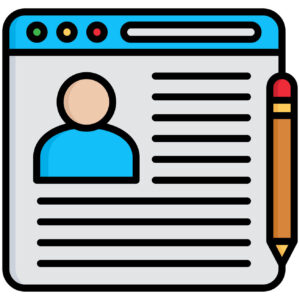
There is a chance that all this still sounds complex or a bit overwhelming, but really, it’s not! Below, I want to share some examples to demonstrate what creating a B2B buyer persona looks like in practice.
Here are four B2B buyer personas tailored to different industries and audience needs:
Persona 1: Tech Solutions Procurement Officer
- Name and Role: Alex Mitchell, Procurement Officer
- Demographics: 35 years old, studied at NYU, lives in San Francisco, CA
- Company Information: Works at a tech company with 300 employees. The company uses online tools like Google Drive, Slack, Trello, and Zoom and flexible work methods.
- Goals and Motivations: Alex wants to make buying processes smoother and keep the company using the latest tech while saving money. He’s all about efficiency and new tech solutions.
- Challenges and Pain Points: Alex finds it tough to manage vendor partnerships and make sure new tools work well with what they already use. Getting good solutions without spending too much is a big hurdle.
- Behavior and Preferences: Likes detailed reports and documents that show how much money they’ll save and how things will fit together. He values good customer service and fast, clear answers.
- Personality Traits: Very analytical, focused on details, and takes initiative. Alex likes to make decisions based on solid information.
Persona 2: Healthcare Operations Manager
- Name and Role: Sarah Thompson, Operations Manager
- Demographics: 50 years old, studied Healthcare Management, lives in Boston, MA
- Company Information: Works at a healthcare provider with over 500 employees, focusing on efficiency and patient care technology. They use Epic, Halo Health, Teladoc, NextGen Healthcare, and IBM Watson Health tools.
- Goals and Motivations: Sarah wants to improve patient care by updating operational systems. She is driven by the desire to enhance healthcare results and make operations more efficient.
- Challenges and Pain Points: Struggles with outdated systems that slow things down. Adding new technology is often expensive and takes a lot of time.
- Behavior and Preferences: Likes webinars and workshops that give practical tips and chances to connect with others in her field. Values examples of successful technology use in healthcare.
- Personality Traits: Works well with others, is social, focused on patient needs, and thinks strategically. Sarah loves solving problems and is eager to bring new ideas to her work.
Persona 3: Retail Marketing Director
- Name and Role: John Lee, Marketing Director
- Demographics: 40 years old, studied Marketing, lives in Chicago, IL
- Company Information: Works at a large retail chain with over 1000 employees, using CRM and digital marketing tools like Hubspot.
- Goals and Motivations: John’s main aim is to boost brand awareness and build customer loyalty through smart marketing. He loves coming up with creative ways to increase sales and customer engagement.
- Challenges and Pain Points: Finds it tough to keep up with fast-changing consumer trends. There’s always pressure to show clear results each year.
- Behavior and Preferences: Relies on marketing reports and trend analysis. Prefers using digital marketing platforms that offer strong analytics features.
- Personality Traits: Thinks creatively, focuses on results, is a bit of a workaholic, and has a visionary outlook. John is driven by strategies based on data and enjoys innovative marketing approaches.
Persona 4: Manufacturing Plant Manager
- Name and Role: Emily Garcia, Plant Manager
- Demographics: 45 years old, studied Industrial Engineering, lives in Detroit, MI
- Company Information: Works in automotive manufacturing with 200 employees, focusing on lean production methods. Uses tools like Oracle, Siemens Opcenter, IQS, and SAP Supply Chain Management.
- Goals and Motivations: Emily wants to boost the plant’s efficiency and cut down on waste while keeping high product quality. She thrives on achieving operational excellence and is always looking for ways to improve.
- Challenges and Pain Points: Finds it challenging to introduce new manufacturing tech and keep equipment running smoothly. Training staff and ensuring safety are also major concerns.
- Behavior and Preferences: Enjoys hands-on demos and training that prove practical use. Relies on dependable tech support and maintenance services.
- Personality Traits: Practical, focuses on details, and driven by efficiency. Emily is dedicated to learning continuously and enhancing productivity.
Can you see how each case is unique and requires a completely tailored approach and marketing strategy? That’s why creating these personas is so important.
The research phase is the most crucial step in creating your B2B buyer persona. As we’ve discussed, surveys are one of the most effective and simple ways to do so.
Next, I’ll share the best tool for researching your customers.
The Best Tool for Doing Buyer Persona Research: UserFeedback
If you’re on WordPress, you’re in luck because you have access to an incredibly powerful tool: UserFeedback.
UserFeedback is the leading survey plugin for WordPress, designed to help you uncover what your customers truly feel and think. It offers a seamless way to collect valuable insights directly from your website visitors.
Here’s why UserFeedback stands out as a top choice:
- Unlimited Surveys and Responses: You can create as many surveys as you need without any restrictions, allowing you to explore every aspect of your customer experience.
- Ready-Made Surveys: If you’re not sure where to start, UserFeedback offers pre-designed templates to help you start your feedback collection easily.
- Customizable Design: Make sure your surveys reflect your brand identity by customizing colors and fonts and adding your logo.
- Conditional Logic: Enhance your surveys with dynamic questions that adapt based on user responses.
- Versatile Question Types: Choose from a variety of question formats, such as open-ended, multiple-choice, star ratings, and even options to collect email addresses.
- Control Over Visibility: With advanced targeting features, you can decide exactly when and to whom your surveys appear, ensuring that you’re always reaching the right audience at the right time.
- Integration and Reporting: UserFeedback integrates with Google Analytics through MonsterInsights, providing easy-to-read reports so you can analyze and store all feedback securely.
UserFeedback is the exact tool you need to truly get inside the minds of your customers. It transforms the often tedious process of gathering feedback into a smooth and easy experience.
Get started with UserFeedback today!
That marks the end of my tutorial on creating a B2B buyer persona. I really hope you liked it and found it helpful. Maybe you’d also like to read How to Reduce Bounce Rate.
And remember to follow us on X and Facebook to learn more about marketing and collecting customer feedback online.
